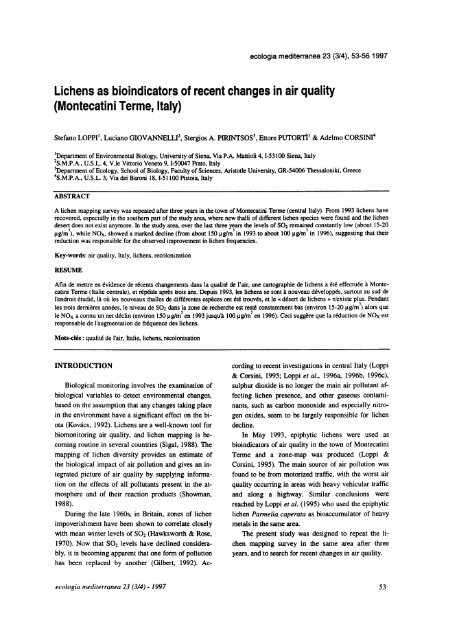1 - Ecologia Mediterranea
1 - Ecologia Mediterranea
1 - Ecologia Mediterranea
Create successful ePaper yourself
Turn your PDF publications into a flip-book with our unique Google optimized e-Paper software.
ecologia mediterranea 23 (314),53-561997<br />
Lichens as bioindicators of recent changes in air quality<br />
(Montecatini Terme, Italy)<br />
Stefano LOPPI 1 , Luciano GlOVANNEW 2 , Stergios A. PIRINTSOS 3 , Ettore PUTORTl:l & Adelmo CORSINI 4<br />
lDepartment of Environmental Biology, University of Siena, Via PA Mattioli 4, 1-53100 Siena, Italy<br />
2S.M.PA, U.S.L. 4, V.le Vittorio Veneto 9,1-50047 Prato, Italy<br />
Jnepartment of Ecology, School of Biology, Faculty of Sciences, Aristotle University, GR-54006 Thessaloniki, Greece<br />
4S.M.P.A., U.S.L. 3, Via dei Baroni 18,1-51100 Pistoia, Italy<br />
ABSTRACT<br />
A lichen mapping survey was repeated after three years in the town of Montecatini Terme (centralltaly). From 1993 lichens have<br />
recovered, especially in the southem part of the study area, where new thalli of different lichen species were found and the lichen<br />
desert does not exist anymore. In the studyarea, over the last three years the levels of S02 remained constantly low (about 15-20<br />
...g1m\ while NOx, showed a marked decline (from about 150 ... g1m 3 in 1993 to about 100 ...g1m 3 in 1996), suggesting that their<br />
reduction was responsible for the observed improvement in lichen frequencies.<br />
Key-words: air quality, Italy, lichens, recolonization<br />
RESUME<br />
Afin de mettre en évidence de récents changements dans la qualité de l'air, une cartographie de lichens a été effectuée à Montecatini<br />
Terme (Italie centrale), et répétée après trois ans. Depuis 1993, les lichens se sont à nouveau développés. surtout au sud de<br />
l'endroit étudié, là où les nouveaux thalles de différentes espèces ont été trouvés, et le « désert de lichens» n'existe plus. Pendant<br />
les trois dernières années, le niveau de S02 dans la zone de recherche est resté constamment bas (environ 15-20 ...glm 3<br />
) alors que<br />
le NOx a connu un net déclin (environ 150 ...glm 3 en 1993 jusqu'à 100 ...glm 3 en 1996). Ceci suggère que la réduction de NOx est<br />
responsable de l'augmentation de fréquence des lichens.<br />
Mots-elés : qualité de l'air, Italie, lichens, recolonisation<br />
INTRODUCTION<br />
Biological monitoring involves the examination of<br />
biological variables to detect environmental changes,<br />
based on the assumption that any changes taking place<br />
in the environment have a significant effect on the bi·<br />
ota (Kovacs, 1992). Lichens are a well-known tool for<br />
biomonitoring air quality, and lichen mapping is be<br />
coming routine in several countries (Sigal, 1988). The<br />
mapping of lichen diversity provides an estimate of<br />
the biological impact of air pollution and gives an in<br />
tegrated picture of air quality by supplying informa<br />
tion on the effects of aIl pollutants present in the at<br />
mosphere and of their reaction products (Showman,<br />
1988).<br />
During the late 1960s, in Britain, zones of lichen<br />
impoverishment have been shown to correlate closely<br />
with mean winter levels of S02 (Hawksworth & Rose,<br />
1970). Now that S02 levels have declined considerably,<br />
it is becoming apparent that one form of pollution<br />
has been replaced by another (Gilbert, 1992). Ac-<br />
ecologia mediterranea 23 (3/4) - 1997<br />
cording to recent investigations in central Italy (Loppi<br />
& Corsini, 1995; Loppi et al., 1996a, 1996b, 1996c),<br />
sulphur dioxide is no longer the main air pollutant af<br />
fecting lichen presence, and other gaseous contami<br />
nants, such as carbon monoxide and especially nitro<br />
gen oxides, seem to be largely responsible for lichen<br />
decline.<br />
In May 1993, epiphytic lichens were used as<br />
bioindicators of air quality in the town of Montecatini<br />
Terme and a zone·map was produced (Loppi &<br />
Corsini, 1995). The main source of air pollution was<br />
found to be from motorized traffic, with the worst air<br />
quality occurring in areas with heavy vehicular traffic<br />
and along a highway. Similar conclusions were<br />
reached by Loppi et al. (1995) who used the epiphytic<br />
lichen Parmelia caperata as bioaccumulator of heavy<br />
metals in the same area.<br />
The present study was designed to repeat the li·<br />
chen mapping survey in the same area after three<br />
years, and to search for recent changes in air quality.<br />
53
















